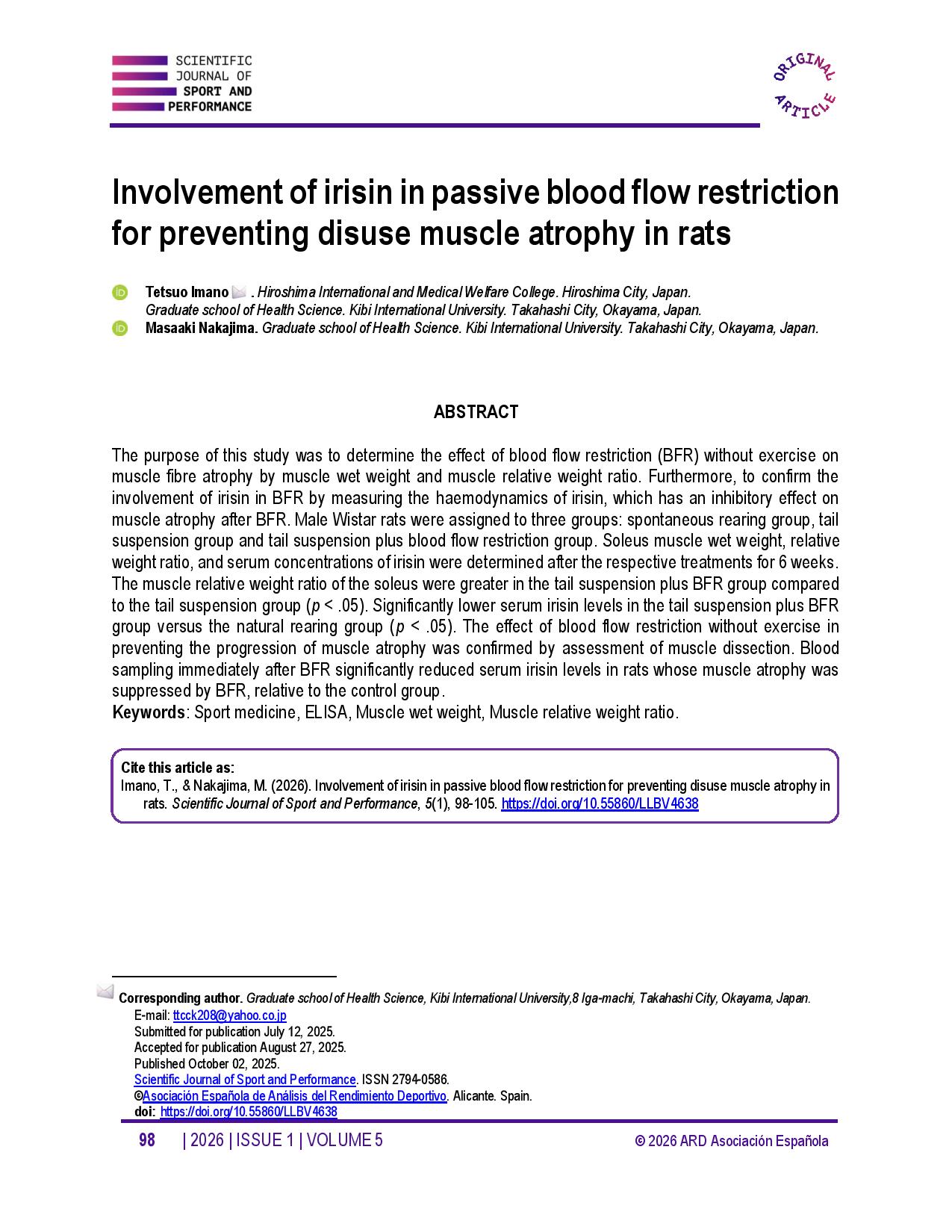Involvement of irisin in passive blood flow restriction for preventing disuse muscle atrophy in rats
Main Article Content
Abstract
The purpose of this study was to determine the effect of blood flow restriction (BFR) without exercise on muscle fibre atrophy by muscle wet weight and muscle relative weight ratio. Furthermore, to confirm the involvement of irisin in BFR by measuring the haemodynamics of irisin, which has an inhibitory effect on muscle atrophy after BFR. Male Wistar rats were assigned to three groups: spontaneous rearing group, tail suspension group and tail suspension plus blood flow restriction group. Soleus muscle wet weight, relative weight ratio, and serum concentrations of irisin were determined after the respective treatments for 6 weeks. The muscle relative weight ratio of the soleus were greater in the tail suspension plus BFR group compared to the tail suspension group (p < .05). Significantly lower serum irisin levels in the tail suspension plus BFR group versus the natural rearing group (p < .05). The effect of blood flow restriction without exercise in preventing the progression of muscle atrophy was confirmed by assessment of muscle dissection. Blood sampling immediately after BFR significantly reduced serum irisin levels in rats whose muscle atrophy was suppressed by BFR, relative to the control group.
Article Details

This work is licensed under a Creative Commons Attribution-NonCommercial-ShareAlike 4.0 International License.
References
Aydin, S., Kuloglu, T., Aydin, S., Kalayci, M., Yilmaz, M., Cakmak, T., Albayrak, S., Gungor, S., Colakoglu, N., Ozercan, I.H. (2014). A comprehensive immunohistochemical examination of the distribution of the fat-burning protein irisin in biological tissues. Peptides, 61, 130-136. https://doi.org/10.1016/j.peptides.2014.09.014 DOI: https://doi.org/10.1016/j.peptides.2014.09.014
Boström, P., Wu, J., Jedrychowski, M. P., Korde, A., Ye, L., Lo, J.C., Rasbach, K, A., Boström, E, A., Choi, J, H., Long, J, Z., Kajimura,S., Zingaretti,M.C., Vind,B.F., Tu,H., Cinti, S., Højlund,K., Gygi, P.S., Spiegelman, B. M. (2012). A PGC1-alpha-dependent myokine that drives brown-fat-like development of white fat and thermogenesis. Nature, 481 (7382), 463-468. https://doi.org/10.1038/nature10777 DOI: https://doi.org/10.1038/nature10777
Colaianni, G,Mongelli, T, Colucci, S , Cinti, S , Grano, M. (2016). Crosstalk between muscle and bone via the muscle-myokine irisin. Curr Osteoporos Rep, 14 (4), 132-137. https://doi.org/10.1007/s11914-016-0313-4 DOI: https://doi.org/10.1007/s11914-016-0313-4
Hamaoka, T., Iwane, H., Kakihira, H., Murase, N., Nishio, S.,Chance, B. (1994). Non-invasive measures of aerobic and anaerobic basal metabolic rates in the skeletal muscle. Med Sci Sports Exerc, 26:98. https://doi.org/10.1249/00005768-199405001-00553 DOI: https://doi.org/10.1249/00005768-199405001-00553
Harada, Y., Tomita, N., Nakajima, M., Ikeuchi, K., Wakitani, S. (2005). Effect of low loading and Joint immobilization for spontaneous repair of osteochondral defect in the knees of Weightless (tail suspension) rats. J Orthop Sci,10(5), 508-514. https://doi.org/10.1007/s00776-005-0931-7 DOI: https://doi.org/10.1007/s00776-005-0931-7
Imano, T., Murao, M., Akiyama, J., Kawakami, T., Nakajima, M. (2020).Temporal Change of Tissue Blood Oxygen Saturation in Rat Skeletal Muscle after Blood Flow Restriction by Manchette (in Japanese). Rigakuryoho Kagaku,35(1),49-52. https://doi.org/10.1589/rika.35.49 DOI: https://doi.org/10.1589/rika.35.49
Ishikawa,A., Tsuji, T.(2016).The impact of rehabilitation on patients undergoing hematopoietic stem cell transplantation. Journal of Hematopoietic Cell Transplantation, 5(4), 107-116 (in Japanese). https://doi.org/10.7889/hct.5.107 DOI: https://doi.org/10.7889/hct.5.107
Kubota, A., Sakuraba, K., Sawaki, K., Sumide, T., Tamura, Y. (2008). Prevention of disuse muscular weakness by restriction of blood flow. Med Sci Sports Exerc, 40(3), 529-534. https://doi.org/10.1249/MSS.0b013e31815ddac6 DOI: https://doi.org/10.1249/MSS.0b013e31815ddac6
Kubota, A., Sakuraba, K., Koh, S., Ogura, Y., Tamura, Y. (2011). Blood flow restriction by low compressive force prevents disuse muscular weakness. J Sci Med Sport, 14(2), 95-99. https://doi.org/10.1016/j.jsams.2010.08.007 DOI: https://doi.org/10.1016/j.jsams.2010.08.007
Morey-Holton, E., Wronski, T. J. (1981). Animal models for simulating weightlessness. Hysiologist, 24: 45-48.
Nakajima, T., Koide, S., Yasuda, T., Hasegawa, T., Yamasoba, T., Obi, S., Toyoda, S., Nakamura, F., Inoue, T., David C Poole, C., D., Kano, Y. (2018). Muscle hypertrophy following blood flow-restricted, low-force isometric electrical stimulation in rat tibialis anterior: role for muscle hypoxia. J Appl Physiol (1985), 125(1): 134-145. https://doi.org/10.1152/japplphysiol.00972.2017 DOI: https://doi.org/10.1152/japplphysiol.00972.2017
Nakajima, T., Yasuda, T., Koide, S., Yamasoba, T., Obi, S., Toyoda, S., Sato, Y., Inoue, T., Kano, Y. (2016). Repetitive restriction of muscle blood flow enhances mTOR signaling pathways in a rat model. Heart Vessels, 31(10), 1685-1695. https://doi.org/10.1007/s00380-016-0801-6 DOI: https://doi.org/10.1007/s00380-016-0801-6
Ohmori, S., Kurokouchi, K., Kanda, K., Kawano, S., Ito, T., Izumi, R., Yasukawa, K., Inazu, M., Murata, Y., Seo, H. (1997). Effect of bisphosphonate administration on the excretion of stress hormones in tail-suspended rats. Environ Med, 41 (1), 9-12.
Roca-Rivada, A., Castelao, C., Senin, L.L., Landrove, M.O., Baltar, J., Crujeiras, A.B.,Seoane, L.M., Casanueva, F.F., Pardo, M. (2013). FNDC5/irisin is not only a myokine but also an adipokine. PLoS One,8 (4), 1-10. https://doi.org/10.1371/journal.pone.0060563 DOI: https://doi.org/10.1371/journal.pone.0060563
Sudo, M., Ando, S., Kano, Y. (2017). Repeated blood flow restriction induces muscle fiber hypertrophy. Muscle Nerve, 55(2), 274-276. https://doi.org/10.1002/mus.25415 DOI: https://doi.org/10.1002/mus.25415
Takarada, Y., Takazawa, H., Ishii, N. (2000). Applications of vascular occlusion diminish disuse Atrophy of knee extensor muscles. Med Sci Sports Exerc, 32(12), 2035-2039. https://doi.org/10.1097/00005768-200012000-00011 DOI: https://doi.org/10.1097/00005768-200012000-00011
Tanimoto, M., Ishii, N. (2006). Effects of low-intensity resistance exercise with slow movement and tonic force generation on muscular function in young men. J Appl Physiol (1985), 100(4), 1150-1157. https://doi.org/10.1152/japplphysiol.00741.2005 DOI: https://doi.org/10.1152/japplphysiol.00741.2005
Tsuchiya, Y., Ando, D., Goto, K., Kiuchi, M., Yamakita, M., Koyama, K. (2014). High-intensity exercise causes greater irisin response compared with low-intensity exercise under similar energy consumption. Tohoku J Exp Med, 233 (2), 135-140. https://doi.org/10.1620/tjem.233.135 DOI: https://doi.org/10.1620/tjem.233.135




